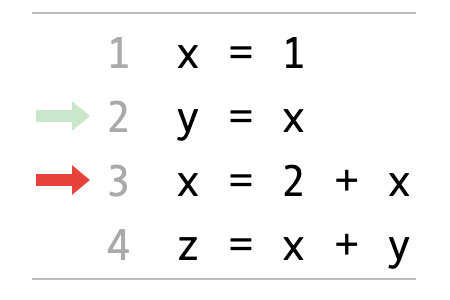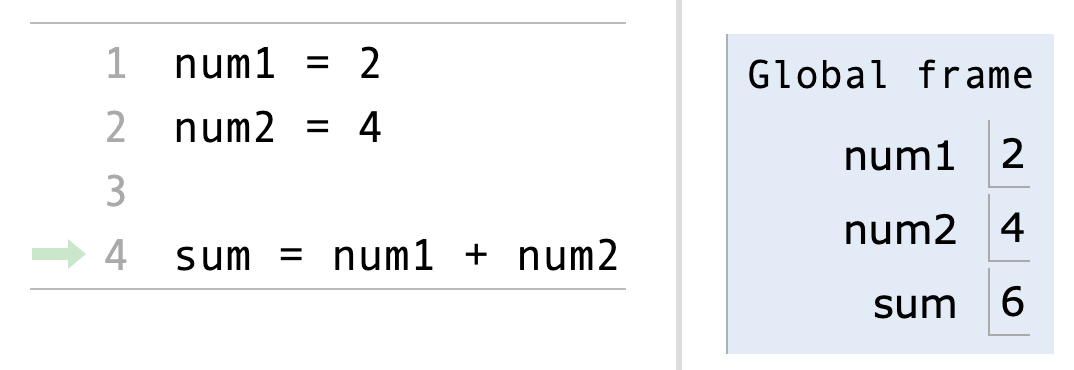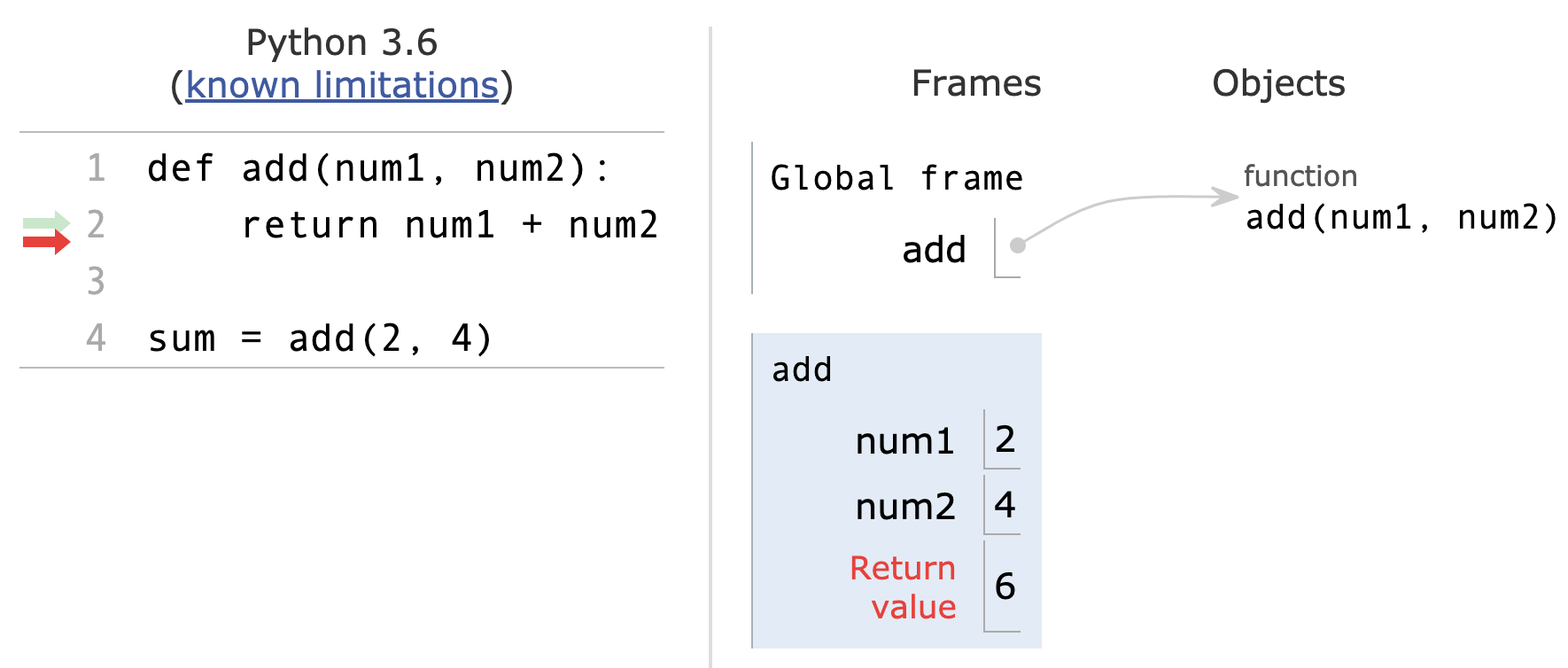Functions
- Press O or Escape for overview mode.
- Press the copy icon on the upper right of code blocks to copy the code
What we'll discuss today...
- Values
- Expressions
- Functions
Community guidelines
Your goal should be to learn and help others learn.
Even if everyone here has programming experience, there is still a wide
range of experience levels. All are welcome!
🧑🏻💻🧑🏼💻👩🏻💻🧑🏽💻🧑🏾💻👩🏽💻🧑🏿💻👩🏾💻👨🏻💻👩🏿💻👨🏼💻👨🏽💻👩🏼💻👨🏾💻👨🏿💻
There are no "stupid" questions. Ask all your questions and welcome everyone
else's questions.
🙋🏻🙋🏼🙋🏿♀️🙋🏽🙋🏾♀️🙋🏾🙋🏿🙋🏽♀️🙋🏻♂️🙋🏼♀️🙋🏼♂️🙋🏽♂️🙋🏻♀️🙋🏾♂️🙋🏿♂️🙋🏻♀️
Expressions & Values
What do programs do?
- Programs work by manipulating values
-
Expressions in programs evaluate to values
- Expression:
'a' + 'hoy' - Value:
'ahoy'
- Expression:
- The Python interpreter evaluates expressions and displays their values
Values
Programs manipulate values.
Each value has a certain data type.
| Data type | Example values |
|---|---|
| Integers | 2 44 -3 |
| Floats | 3.14 4.5 -2.0 |
| Booleans | True False |
| Strings | '¡hola!' 'its python time!' |
Try in a Python interpreter, like on code.cs61a.org.
Expressions (with operators)
An expression describes a computation and evaluates to a value.
Some expressions use operators:
18 + 69
6/23
2 * 100
2 ** 100
Try in a Python interpreter, like on code.cs61a.org.
Call expressions
Many expressions use function calls:
pow(2, 100)
max(50, 300)
min(-1, -300)
Expressions (both ways)
Expressions with operators can also be expressed with function call notation:
2 ** 100
pow(2, 100)
Anatomy of a Call Expression
| add | ( | 18 | , | 69 | ) |
| Operator | Operand | Operand |
How Python evaluates a call expression:
- Evaluate the operator
- Evaluate the operands
- Apply the operator (a function) to the evaluated operands (arguments)
Operators and operands are also expressions, so they must be evaluated to discover their values.
Evaluating nested expressions
This is called an expression tree.
Exercise: Expressions
After the lecture, you can try out this exercise. (Not graded, just another way to engage with the material!)
Names

Names
A name can be bound to a value.
One way to bind a name is with an assignment statement:
| x | = | 7 |
| Name | Value |
The value can be any expression:
| x | = | 1 + 2 * 3 - 4 // 5 |
| Name | Expression |
Using names
A name can be referenced multiple times:
x = 10
y = 3
result1 = x * y
result2 = x + y
A name that's bound to a data value is also known as a variable.
Name rebinding
A name can only be bound to a single value.
my_name = 'Pamela'
my_name = my_name + 'ela'
💬 Will that code error? If not, what will my_name store?
It will not error (similar code in other languages might, however). The
name my_name is now bound to the value 'Pamelaela'.
Exercise
Try this after the lecture...
What will be the value of the final expression in this sequence?
f = min
f = max
g = min
h = max
max = g
max(f(2, g(h(1, 5), 3)), 4)
Don't write like that. Names matter!
Environment diagrams
Environment diagrams
An environment diagram is a visualization of how Python interprets a program. Use the free website PythonTutor to generate diagrams. View example
| Code (left) | Frames (right) |
|---|---|

|

|
| Arrows indicate the order of execution. Green = just executed, red = up next. |
Each name is bound to a value. Within a frame, each name cannot be repeated. |
Assignments in Environment diagrams
How Python interprets an assignment statement:
- Evaluate the expression to the right of
=. -
Bind the expression's value to the name that's on the left side of the
=sign.

Functions
What is a function?
A function is a sequence of code that performs a particular task and can be easily reused. ♻️
We've already used functions:
add(18, 69)
mul(60, sub(5, 4))
A function takes inputs (the arguments) and returns an output (the return value).
18, 69 → add → 87
Defining functions
The most common way to define functions is Python is the
def statement.
def <name>(<parameters>):
return <return expression>
Example:
def add(num1, num2):
return num1 + num2
Once defined, we can call it:
add(2, 2)
add(18, 69)
Anatomy of a function definition
The first line is called the function signature, all lines after are considered the function body.
def <name>(<parameters>): # ← Function signature
return <return expression> # ← Function body
def add(num1, num2): # ← Function signature
return num1 + num2 # ← Function body
The function body can have multiple lines:
def add(num1, num2): # ← Function signature
sum = num1 + num2 # ← Function body
return sum # ← Function body
Function arguments
We can pass in any expressions as arguments.
def add(num1, num2):
return num1 + num2
x = 1
y = 2
add(x, y)
x = 3
add(x * x, x + x)
Return values
The return keyword returns a value to whoever calls the function (and exits the function).
def add(num1, num2):
return num1 + num2
sum = add(2, 4)
Reminder: You can use function calls in expressions:
big_sum = add(200, 412) + add(312, 256)
...and nest function calls inside function calls:
huge_sum = add(add(200, 412), add(312, 256))
Spot the bug #1
What's wrong with this code?
def add(num1, num2):
return sum
sum = num1 + num2
sum = add(2, 4)
The code after the return statement will not be executed, that line belongs before the return.
Spot the bug #2
What's wrong with this code?
def add():
return num1 + num2
sum = add(2, 4)
The function body is referring to variables that don't seem to exist. Most likely, they should be parameters in the function signature.
Spot the bug #3
What's wrong with this code?
def add(num1, num2):
sum = num1 + num2
sum = add(2, 4)
The function body does not return any value. However, the code that calls it tries to use the result of the expression. It should have a return statement that returns the sum.
Functions in environment diagrams
How Python interprets a def statement:
-
It creates a function with the
nameandparameters - It sets the function body to everything indented after the first line
- It binds the function name to that function body (similar to an assignment statement)

Function calls in environment diagrams
How Python interprets a function call:
- It creates a new frame in the environment
- It binds the function call's arguments to the parameters in that frame
- It executes the body of the function in the new frame

More on names
Names and environments
All Python code is evaluated in the context of an environment, which is a sequence of frames.
We've seen two possible environments:
| Global frame |

|
|
Function's local frame, child of Global frame |

|
Name lookup rules
How Python looks up names in a user-defined function:
- Look it up in the local frame
- If name isn't in local frame, look it up in the global frame
- If name isn't in either frame, throw a NameError
*This is simplified since we haven't learned all the Python features that complicate the rules.
Name lookup example #1
def exclamify(text):
start_exclaim = "¡"
end_exclaim = "!"
return start_exclaim + text + end_exclaim
exclamify("the snails are eating my lupines")
-
On line 4, which frame is
start_exclaimfound in?
The local frame for exclamify -
On line 4, Which frame is
textfound in?
The local frame for exclamify -
On line 6, which frame is
exclamifyfound in?
The global frame
Name lookup example #2
start_exclaim = "¡"
end_exclaim = "❣️"
def exclamify(text):
return start_exclaim + text + end_exclaim
exclamify("the voles are digging such holes")
-
On line 5, which frame is
start_exclaimfound in?
The global frame -
On line 5, Which frame is
textfound in?
The local frame for exclamify -
On line 6, which frame is
exclamifyfound in?
The global frame
Name lookup example #3
def exclamify(text):
end_exclaim = "⁉️️️"
return start_exclaim + text + end_exclaim
exclamify("the voles are digging such holes")
-
Which name will cause a
NameError?
Thestart_exclaimname, since it was never assigned. -
When will that error happen?
It will happen whenexclamifyis called and Python tries to execute the return statement.
Summary
- Programs consist of statements, or instructions for the computer, containing expressions, which describe computation and evaluate to values.
- Values can be assigned to names to avoid repeating computations.
- An assignment statement assigns the value of an expression to a name in the current environment.
- Functions encapsulate a series of statements that maps arguments to a return value.
- A def statement creates a function object with certain parameters and a body and binds it to a name in the current environment.
- A call expression applies the value of its operator, a function, to the value(s) or its operand(s), some arguments.
Exercises
You can try these exercises after the lecture for some additional practice:
To run the doctests, press the red test tube in the upper right corner.